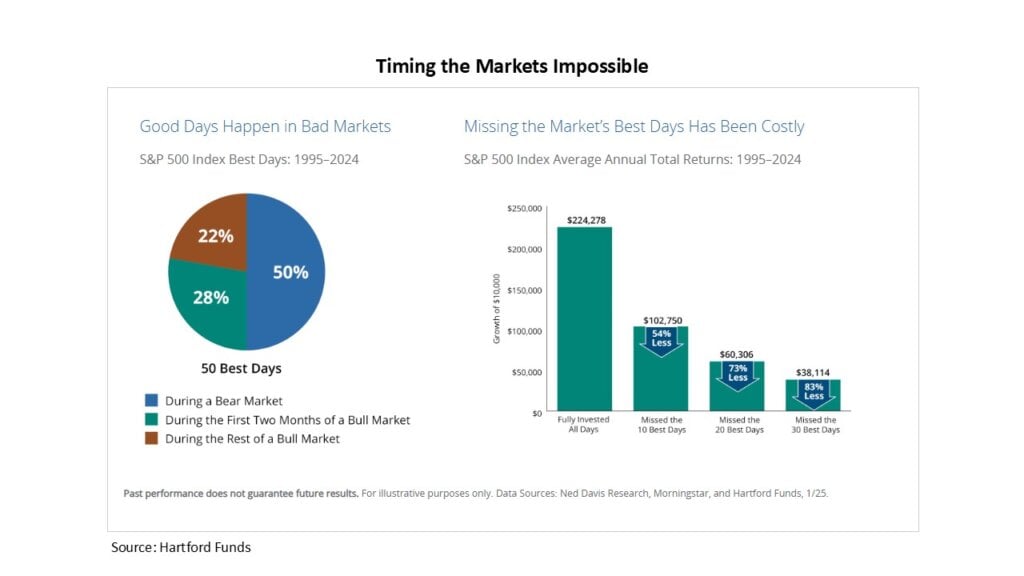Don’t dwell on a possible pullback
Allan Small explains why it’s always the right time to be in the markets—even when they are near record highs.
Advertisement
Allan Small explains why it’s always the right time to be in the markets—even when they are near record highs.

At the time of writing, the S&P 500, Nasdaq Composite, and Dow Jones Industrial Average were all trading at levels hovering around all-time highs. But as we turned into the second half of November, some uncertainty crept into the markets’ performance. A climbing stock market, at least on the surface, should be a time for optimism—but for many investors, it’s cause for concern. Understanding that what goes up eventually comes down, they’re worried about a potential pullback or deeper correction.
Fuelling the current fear of a selloff are the pundits. New York Times financial journalist Andrew Ross Sorkin is comparing today’s booming markets to those of the 1920s before the crash. And Michael Burry, the hedge fund manager who predicted the collapse of the U.S. housing market in 2008, is betting against artificial intelligence stocks Nvidia and Palantir Technologies. This led to the tech-heavy Nasdaq having one of its worst weeks this year. But Nvidia is worth more than US$4.5 trillion and Palantir is worth more than US$4 billion. Their fundamentals are strong.
My advice: It’s important to keep things in perspective. Yes, we are near all-time highs, and yes, markets go up and down. But over time they rise to ever greater heights. In 1972, the Dow Jones crossed the 1,000-point mark for the first time. Today, it’s at nearly 48,000 points. Market corrections are common and healthy. In a 12-month period, markets may correct 5% to 7% a couple of times. A loss of 20% or greater—a big bear-market type of correction—may happen once or twice in a three-to-five-year period, or three to four times every decade.
We just had one. In April, when Donald Trump announced reciprocal tariffs, the markets sold off nearly 20%. This was a reaction based purely on politics and had nothing to do with the health of the companies. Since then, all three U.S. stock market indexes have ramped up and, with a few exceptions, haven’t really stopped.
We’ve had three years of fantastic returns. Over that time, the S&P 500 is up more than 70%, with some investors averaging 20% year-over-year returns. The markets went way higher than most of us anticipated; the norm is probably closer to 10%. Even if the markets fall between 5% and 10% in what’s left of the year, portfolios are still way up. This is not a doom-and-gloom scenario.
I’m not afraid of a dip or even a big correction—not because they can’t happen, because at some point they will. The pattern is simple and historically proven: markets go up, hit new highs, give some back, form a base, start moving back higher, reach the old height, surpass it, and then give back some again. That’s the cycle. People shouldn’t get caught up in this idea that you are losing when there is a decline. It’s just the market giving back some of the gains you’ve had the good fortune to make. Those gains will come back again, provided you stay invested.
Just as there is no way to capture 100% of the upside in every cycle, it’s impossible to figure out when the exact moment a market is going to start falling and how long it will keep falling. Put another way, no one can consistently time the markets, so don’t try to. I tell investors to enjoy the ride because time in the market is what will determine the long-term performance of your portfolio.
Research from Hartford Funds shows that over the past 30 years, 25 of the S&P 500’s 50 best days happened during a bear market. Investors who missed the 10 best days during this time frame had 54% lower returns than investors who remained fully invested—and strategic.

The important thing is to understand your money goals; this will help you decide what types of assets will get you there. If you’re looking for growth, there is a strong case that there are no alternatives to investing in equities because interest rates are so low.
Continue to look for good-quality companies that are profitable and have solid growth potential. Don’t chase trends or the next “it” stock. Make sure your portfolio is diversified and not overweight in any one company or sector. Regularly assess your portfolio with an eye to risk management. Trim profits from your winners and reinvest those profits into stocks that represent good value.
This is a recipe for success in all markets, hot and not.
Share this article Share on Facebook Share on Twitter Share on Linkedin Share on Reddit Share on Email